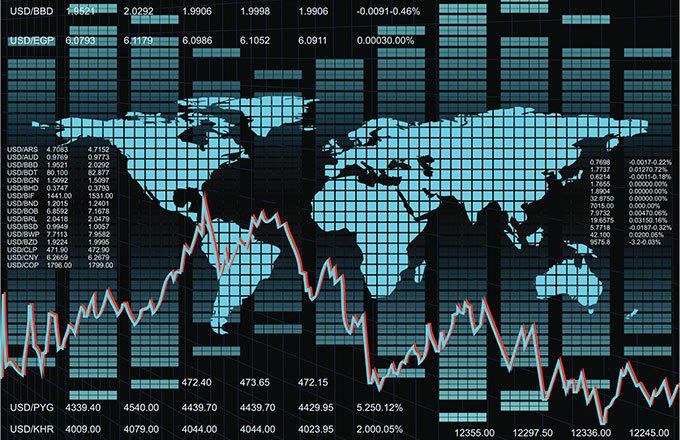
The most complex types of investment products often fall under the broad category of derivative securities. For most investors, the derivative instrument concept is hard to understand. However, since derivatives are typically used by governmental agencies, banking institutions, asset management firms, and other types of corporations to manage their investment risks, it is important for investors to have a general knowledge of what these products represent and how they are used by investment professionals.
Indeed, one of the oldest and most commonly used derivatives is the forward contract, which serves as the conceptual basis for many other types of derivatives that we see today. Here, we take a closer look at forwards and understand how they work and where they are used.
Key Takeaways
- A forward contract is a customized derivative contract obligating counterparties to buy (receive) or sell (deliver) an asset at a specified price on a future date.
- A forward contract can be used for hedging or speculation, although its non-standardized nature makes it particularly useful for hedging.
- In forex markets, forwards are used to exploit arbitrage opportunities at the cost of carrying different currencies.
- Understanding how forwards work can unlock a greater understanding of more complex and nuanced derivatives products like options and swaps.
Trading and Settlement Procedures
Forward contracts trade in the over-the-counter (OTC) market, meaning they do not trade on an exchange. When a forward contract expires, the transaction is settled in one of two ways. The first way is through a process known as “physical delivery.”
Under this type of settlement, the party that is long the forward contract position will pay the party that is short the position when the asset is actually delivered and the transaction is finalized. While the transactional concept of “delivery” is simple to understand, the implementation of delivering the underlying asset may be very difficult for the party holding the short position. As a result, a forward contract can also be completed through a process known as “cash settlement.”
A cash settlement is more complex than a delivery settlement, but it is still relatively straightforward to understand. For example, suppose that at the beginning of the year a cereal company agrees through a forward contract to buy 1 million bushels of corn at $5 per bushel from a farmer on Nov. 30 of the same year.
At the end of November, suppose that corn is selling for $4 per bushel on the open market. In this example, the cereal company, which is long the forward contract position, is due to receive from the farmer an asset that is now worth $4 per bushel. However, since it was agreed at the beginning of the year that the cereal company would pay $5 per bushel, the cereal company could simply request that the farmer sell the corn in the open market at $4 per bushel, and the cereal company would make a cash payment of $1 per bushel to the farmer. Under this proposal, the farmer would still receive $5 per bushel of corn.
In terms of the other side of the transaction, the cereal company would then simply purchase the necessary bushels of corn in the open market at $4 per bushel. The net effect of this process would be a $1 payment per bushel of corn from the cereal company to the farmer. In this case, a cash settlement was used for the sole purpose of simplifying the delivery process.
Currency Forward Contracts
Forward contracts can be tailored in a manner that makes them complex financial instruments. A currency forward contract can be used to help illustrate this point. Before a currency forward contract transaction can be explained, it is first important to understand how currencies are quoted to the public, versus how they are used by institutional investors to conduct financial analysis.
If a tourist visits Times Square in New York City, he will likely find a currency exchange that posts exchange rates of foreign currency per U.S. dollar. This type of convention is used frequently. It is known as an indirect quote and is probably the manner in which most retail investors think in terms of exchanging money.
However, when conducting financial analysis, institutional investors use the direct quotation method, which specifies the number of units of domestic currency per unit of foreign currency. This process was established by analysts in the securities industry, because institutional investors tend to think in terms of the amount of domestic currency required to buy one unit of a given stock, rather than how many shares of stock can be bought with one unit of the domestic currency. Given this convention standard, the direct quote will be utilized to explain how a forward contract can be used to implement a covered interest arbitrage strategy.
Assume that a U.S. currency trader works for a company that routinely sells products in Europe for Euros, and that those Euros ultimately need to be converted back to U.S. Dollars. A trader in this type of position would likely know the spot rate and forward rate between the U.S. Dollar and the Euro in the open market, as well as the risk-free rate of return for both instruments.
For example, the currency trader knows that the U.S. Dollar spot rate per Euro in the open market is $1.35 U.S. Dollars per Euro, the annualized U.S. risk-free rate is 1% and the European annual risk-free rate is 4%. The one-year currency forward contract in the open market is quoted at a rate of $1.50 U.S. Dollars per Euro. With this information, it is possible for the currency trader to determine if a covered interest arbitrage opportunity is available, and how to establish a position that will earn a risk-free profit for the company by using a forward contract transaction.
A Covered Interest Arbitrage Strategy
To initiate a covered interest arbitrage strategy, the currency trader would first need to determine what the forward contract between the U.S. Dollar and Euro should be in an efficient interest rate environment. To make this determination, the trader would divide the U.S. Dollar spot rate per Euro by one plus the European annual risk-free rate, and then multiply that result by one plus the annual U.S. risk-free rate.
[1.35 / (1 + 0.04)] x (1 + 0.01) = 1.311
In this case, the one-year forward contract between the U.S. Dollar and the Euro should be selling for $1.311 U.S. Dollars per Euro. Since the one-year forward contract in the open market is selling at $1.50 U.S. Dollars per Euro, the currency trader would know that the forward contract in the open market is overpriced. Accordingly, an astute currency trader would know that anything that is overpriced should be sold to make a profit, and therefore the currency trader would sell the forward contract and buy the Euro currency in the spot market to earn a risk-free rate of return on the investment.
Example
The covered interest arbitrage strategy can be achieved in four simple steps:
Step 1:
The currency trader would need to take $1.298 and use it to buy €0.962.
To determine the amount of U.S. Dollars and Euros needed to implement the covered interest arbitrage strategy, the currency trader would divide the spot contract price of $1.35 per Euro by one plus the European annual risk-free rate of 4%.
1.35 / (1 + 0.04) = 1.298
In this case, $1.298 would be needed to facilitate the transaction. Next, the currency trader would determine how many Euros are needed to facilitate this transaction, which is simply determined by dividing one by one plus the European annual risk-free rate of 4%.
1 / (1 + 0.04) = 0.962
The amount that is needed is €0.962.
Step 2:
The trader would need to sell a forward contract to deliver €1.0 at the end of the year for a price of $1.50.
Step 3:
The trader would need to hold the Euro position for the year, earning interest at the European risk-free rate of 4%. This position would increase in value from €0.962 to €1.00.
0.962 x (1 + 0.04) = 1.000
Step 4:
Finally, on the forward contract expiration date, the trader would deliver the €1.00 and receive $1.50. This transaction would equate to a risk-free rate of return of 15.6%, which can be determined by dividing $1.50 by $1.298 and subtracting one from the sum to determine the rate of return in the proper units.
(1.50 / 1.298) – 1 = 0.156
The mechanics of this covered interest arbitrage strategy are very important for investors to understand, because they illustrate why interest rate parity must hold true at all times to keep investors from making unlimited risk-free profits.
Covered Interest Arbitrage
Forward Market Opacity
Forwards provide a level of privacy to both the buyer and seller, and they can be customized to meet both the buyer’s and seller’s specific needs and intentions. Unfortunately, due to the opaque features of forward contracts, the size of the forward market is not accurately known. This, in turn, makes the extent of forward markets less understood than some other derivative markets.
Due to the lack of transparency that is associated with the use of forward contracts, some potential issues may arise. For example, parties that utilize forward contracts are subject to default risk, their trade completion may be problematic due to the lack of a formalized clearinghouse, and they are exposed to potentially large losses if the derivatives contract is structured improperly.
As a result, there is the potential for severe financial problems in the forward markets to overflow from the parties that engage in these types of transactions to society as a whole.
To date, severe problems such as systemic default among the parties that engage in forward contracts have not come to fruition. Nevertheless, the economic concept of “too big to fail” will always be a concern, so long as forward contracts are allowed to be undertaken by large organizations. This problem becomes an even greater concern when both the options and swaps markets are taken into account.
Forward Contracts and Other Derivatives
As this article illustrates, forward contracts can be tailored as very complex financial instruments. The breadth and depth of these types of contracts expand exponentially when one takes into account the different types of underlying financial instruments that can be used to implement a forward contract strategy.
Examples include the use of equity forward contracts on individual stock securities or index portfolios, fixed income forward contracts on securities such as treasury bills, and interest rate forward contracts on rates such as the Secured Overnight Financing Rate (SOFR), which are more commonly known in the industry as forward-rate agreements.
Finally, investors should understand that forward contract derivatives are typically considered the foundation of futures contracts, options contracts, and swaps contracts. This is because futures contracts are basically standardized forward contracts that have a formalized exchange and clearinghouse.
Options contracts are basically forward contracts that provide an investor an option, but not an obligation, to complete a transaction at some point in time. Swaps contracts are basically linked-chain agreements of forward contracts that require action to be taken by investors periodically over time.
What Is a Forward Hedge?
A forward hedge is a classic use of forward contracts to lock in a price today for a product to be bought or sold at a later date. Imagine a farmer plants corn seed in May and harvests in October. The farmer does not want to speculate on the price of corn between May and October, but prefers to lock in the current price, which the farmer has used to budget operating expenses and estimate profit margins. So, the farmer sells a forward contract for corn today. In October, the farmer harvests the corn and sells it. At the same time, they buy back their forward contract. In this way, the farmer has locked-in the price in May, since if Corn rose in the meantime, they would see a profit from the sale of corn but an equivalent loss in the forward. Likewise, if corn prices fell, they would profit from the forward but lose on the physical corn.
When Was the First Forward Contract Invented?
Financial historians estimate that forward contracts originated early on in human history, as soon as civilization began growing and trading agricultural products. The use of forwards can be traced to Greek and Roman times, and may have occurred earlier still; they have been widely traded in Europe (and subsequently elsewhere) since the Middle Ages.
How Do Forward and Futures Contracts Differ?
Forwards and futures, in many ways, operate in the same way. The major difference is that futures contracts have standardized terms and are traded on exchanges, while forwards are customizable and trade over-the-counter (OTC).
The Bottom Line
Once the link between forward contracts and other derivatives is understood, investors can start to realize the financial tools that are at their disposal, the implications that derivatives have for risk management, and how potentially large and important the derivatives market is to a host of governmental agencies, banking institutions, and corporations throughout the world.
Investopedia does not provide tax, investment, or financial services and advice. The information is presented without consideration of the investment objectives, risk tolerance, or financial circumstances of any specific investor and might not be suitable for all investors. Investing involves risk, including the possible loss of principal.


